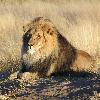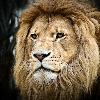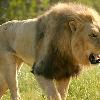

Lion lying down in Namibia Tags: Lion View |
Tags: Lion View |
Tags: Lion View |
|||||||||
P. leo binomial=Panthera leo binomial_authority=(Linnaeus (Carl Linnaeus), 1758) synonyms=Felis leo Linnaeus (Carolus Linnaeus), 1758 range_map=Lion_distribution.png range_map_width=250px range_map_caption=Historic (red) and present (blue) distribution of lions range_map2=Map Guj Nat Parks Sanctuary.png range_map2_width=250px range_map2_caption=Distribution of lions in India. The Gir Forest, in the State of Gujarat, is the last natural range of approximately 300 wild Asiatic Lions. There are plans to reintroduce some lions to Kuno Wildlife Sanctuary in the neighboring State of Madhya Pradesh.
The lion (Panthera leo) is one of the four big cats in the genus Panthera, and a member of the family Felidae. With some males exceeding 250 kg (550 lb (pound (mass))) in weight, it is the second-largest living cat after the tiger. Wild lions currently exist in Sub-Saharan Africa and in Asia with a critically endangered (critically endangered species) remnant population in Gir Forest National Park in India, having disappeared from North Africa and Southwest Asia in historic times. Until the late Pleistocene, about 10,000 years ago, the lion was the most widespread large land mammal after humans. They were found in most of Africa, much of Eurasia from western Europe to India, and in the Americas from the Yukon to Peru.
Lions live for ten to fourteen years in the wild, while in captivity they can live longer than twenty years. In the wild, males seldom live longer than ten years, as injuries sustained from continual fighting with rival males greatly reduce their longevity. They typically inhabit savanna and grassland, although they may take to bush and forest. Lions are unusually social (social animal) compared to other cats. A pride of lions consists of related females and offspring and a small number of adult males. Groups of female lions typically hunt together, preying mostly on large ungulates. Lions are apex (apex predator) and keystone (keystone species#Predators) predators, although they scavenge as opportunity allows. While lions do not typically hunt humans selectively, some have been known to seek human prey.
The lion is a vulnerable species, having seen a possibly irreversible population decline of thirty to fifty percent over the past two decades in its African range. Lion populations are untenable outside of designated reserves and national parks. Although the cause of the decline is not fully understood, habitat loss and conflicts with humans are currently the greatest causes of concern. Lions have been kept in menageries since Roman times (Roman era) and have been a key species sought for exhibition in zoos the world over since the late eighteenth century. Zoos are cooperating worldwide in breeding programs for the endangered Asiatic subspecies (Asiatic Lion).
Visually, the male lion is highly distinctive and is easily recognized by its mane. The lion, particularly the face of the male, is one of the most widely recognized animal symbols in human culture. Depictions have existed from the Upper Paleolithic period, with carvings and paintings from the Lascaux and Chauvet Caves, through virtually all ancient and medieval cultures where they historically occurred. It has been extensively depicted in literature, in sculptures, in paintings, on national flags, and in contemporary films and literature.
Fossil Range: Early Pleistocene to recent
Status System: iucn3.1
Trend: down
Image2: Okonjima Lioness.jpg
Image2 Caption: Female (Lioness)
Regnum: Animalia
Phylum: Chordata (Chordate)
Classis: Mammalia
Ordo: Carnivora
Familia: Felidae
Genus: ''Panthera''



